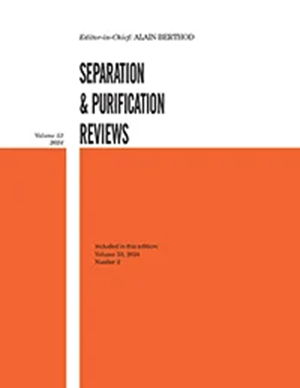纳米吸附剂在水中除氟的应用:最新进展和未来展望
IF 5.6
2区 工程技术
Q1 CHEMISTRY, ANALYTICAL
引用次数: 0
摘要
氟化物因其潜在的毒性和对健康的负面影响而成为全球关注的污染物。吸附法因其成本效益和效率高而被认为是消除氟化物污染最有前途的方法。纳米材料因其高比表面积、高吸附性能和易于自组装而成为除氟的优良吸附剂。然而,纳米吸附剂在废水处理中的应用仍存在一些挑战。因此,本文综述了纳米吸附剂在除氟方面的研究进展,并从不同的维度对纳米吸附剂的结构和吸附性能有了基本的了解。研究了不同纳米组分对吸附性能的协同效应。此外,提出了纳米吸附剂在工程应用中面临的挑战和解决这些问题的建议,以促进其实际应用前景。关键词:吸附;氟烷吸附剂;水修复。52170096)、鄂尔多斯科技重大专项(2022EEDSKJZDZX015)和中央高校基本科研业务费专项(NO.2022YJSHH07)。披露声明作者未报告潜在的利益冲突。作者:陆文静:概念、方法、调查、资源、写作-原稿、写作-审稿、编辑。张春辉:概念、方法、资源、写作评审与编辑、可视化、监督、项目管理、资金获取。杜彦斌:调研、资源、可视化。权炳旭:调查、资源、写作——原稿。秦兆伟:调查;方法。程凯鹏:调查;方法。艾力尼亚兹:资源,写作-原稿。苏培东:方法论、资源、写作审编、可视化、监督。感谢中央高校基本科研业务费专项资金(NO.2022YJSHH07)由中国国家留学基金委国际访问学者计划资助(No.202306430016)。本文章由计算机程序翻译,如有差异,请以英文原文为准。
Applications of Nanoadsorbents for the Removal of Fluoride from Water: Recent Advancements and Future Perspectives
ABSTRACTFluoride has become a globally concerning pollutant due to its potential toxicity and negative health impacts. Adsorption has been regarded as the most promising approach for the elimination of fluoride contamination owing to its cost-effectiveness and high efficiency. Nanomaterials are excellent adsorbents for defluoridation due to their high specific surface area, high adsorption properties, and ease of self-assembly. However, there are still some challenges in the application of nanoadsorbents for wastewater treatment. Therefore, this review summarizes the research progress of nanoadsorbents for fluoride removal and develops a fundamental understanding of the structure and adsorption properties of nanoadsorbents in different dimensions. It studies the synergistic effects of different nano- components in adsorption capabilities. In addition, challenges related to the engineering applications of nanoadsorbents and some suggestions to address these issues are presented to promote their practical application prospects.KEYWORDS: Adsorptionfluoridenanoadsorbentswater remediation ACKNOWLEDGMENTSThis work was financially supported by the National Natural Science Foundation of China (NO. 52170096) and the Major Projects of Erdos Science and Technology (2022EEDSKJZDZX015) and the Fundamental Research Funds for the Central Universities (NO.2022YJSHH07).DISCLOSURE STATEMENTNo potential conflict of interest was reported by the author(s).AUTHOR CONTRIBUTIONSWenjing Lu: Conceptualization, methodology, investigation, resources, writing-original draft, writing-review & editing. Chunhui Zhang: conceptualization, methodology, resources, writing - review & editing, visualization, supervision, project administration, funding acquisition. Yanbin Du: investigation, resources, visualization. Bingxu Quan: investigation, resources, writing-original draft. Zhaowei Qin: investigation; methodology. Kaipeng Cheng: investigation; methodology. Aili Niyazi: resources, writing - original draft. Peidong Su: methodology, resources, writing - review & editing, visualization, supervision.Additional informationFundingFundamental Research Funds for the Central Universities (NO.2022YJSHH07) to the financial support from International Visiting Scholar Program of China Scholarship Council is gratefully acknowledged (No.202306430016).
求助全文
通过发布文献求助,成功后即可免费获取论文全文。
去求助
来源期刊
CiteScore
12.20
自引率
1.90%
发文量
24
审稿时长
6 months
期刊介绍:
Separation & Purification Reviews provides comprehensive summaries and interdisciplinary viewpoints of significant developments in all areas of separation and purification, including innovative methods, apparatus, theories, and applications. The journal presents reviews that cover a large amount of scientific/technical information in a concise and organized manner on topics such as adsorption, centrifugation, chromatography, crystallization, distillation, extraction, filtration, ion exchange, membrane separations of solid, liquid or gaseous materials.

 求助内容:
求助内容: 应助结果提醒方式:
应助结果提醒方式:


